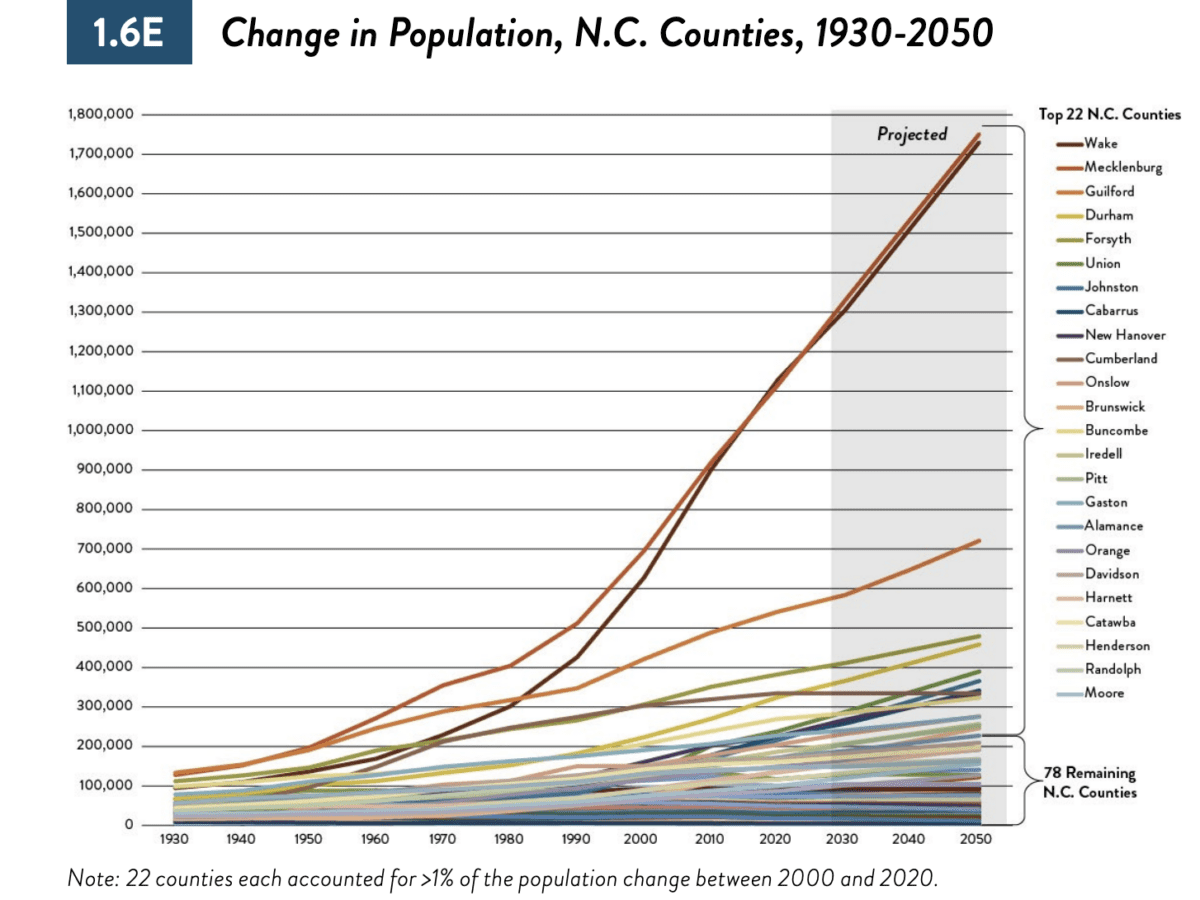

The 630,000 North Carolina children 5 to 9 years old — the ages for kindergarten through fourth grade — will become adults in their mid-30s at mid-century. The outset of the 2023-24 academic cycle offers a moment to reflect on education as both an individual and public asset in the present and especially for the future.
Today’s elementary-grade students who remain or move into North Carolina by 2050 will have a role in defining a state further transformed by population growth and change. Many surely will work in jobs still to be envisioned and created.
A dramatic image of mid-century North Carolina comes in a recent Daily Digest of Business North Carolina, which drew from a report of the state Board of Science, Technology, and Innovation. It consists of a chart tracking county-by-county population from 1930 to 2020, and projected to 2050.
In 1930, the populations of the 100 counties were “relatively similar.” In the last quarter of the 20th Century, counties diverged, with Wake and Mecklenburg turning sharply upward, projected to reach nearly 1.8 million residents each in 2050. Those two counties, plus Guilford, Durham and, Forsyth, are projected to account for 36% of the state’s 2050 population.
“To the extent state leaders want that growth to continue, and to the extent that it actually does continue, the need to enhance and grow infrastructure (schools, utilities, roads/ transit, broadband, water/sewer, etc.) will increase as well,” says the state board report.
Additional layers of analysis come from demographers scouring the recent Census Bureau release of detailed 2010-2020 data on age, race, and ethnicity. These data, too, contribute to an understanding of 21st Century North Carolina — and America as well.
The state’s demographer, Michael Cline, identifies “15 things we learn” from the 2020 Census. With nearly 3.5 million rural residents, North Carolina has the second largest rural population, trailing only Texas, he reaffirms.
Cline reports that the aging of the baby-boom generation has resulted in 56 counties with 20% or more of the total population consisting of people 65 years and older – up from 15 counties in 2010. Meanwhile, he writes, “School-aged population grew in only 32 of our 100 counties.The largest gains in the school-aged population (ages 5 to 17) were in Wake (34,971), Mecklenburg (22,646), Cabarrus (8,729), Johnston (8,426), Durham (5,717), and Union (5,199) counties.”
Brookings Institution scholar William H. Frey, a preeminent national demographer, finds in the new Census data evidence of a “racial generation gap.” Frey’s paper contains both state-level and major metropolitan data, including the Raleigh and Charlotte regions.
“White Americans contributed substantially to older population gains compared to younger and middle-aged populations, which registered white declines,” Frey writes. “Nonwhite residents accounted for all of the gains in post-baby-boomer populations.”
In North Carolina, Frey calculates a 27.4% difference between the share of whites in the 65-plus population and in residents 18 and younger. Among North Carolinians 65 and older, 76.6% are white, 16.6% are black, with relatively small segments of ethnic groups. In contrast, among 18-and-under North Carolinians, 49.1% are whites, 21.3% are blacks, 17.3% Hispanic or Latino, with Asian-Americans and American Indians in the remaining 12%.
Growth has been so strong that the Raleigh-Cary region and the Charlotte-Concord-Gastonia region rank near the top of U.S. metropolitan regions in the percentage of 2010-to-2020 increase in both under-18 and over-65 segments of the population, according to Frey. Raleigh ranked in the top three, Charlotte just under the top 10.
Frey says that “substantial old-young racial gaps … are likely to persist in the near term. This is reflected in a cultural generation gap that underlies many aspects of the nation’s social fabric and politics, including views about the recent Supreme Court decision on affirmative action and state proposals to limit teaching about race and diversity in public schools.”
For North Carolina to muster the public will and leadership to overcome its “racial generation gap” would make a critical difference in the education and lives of the children returning to class now in a lingering summertime heat wave.


